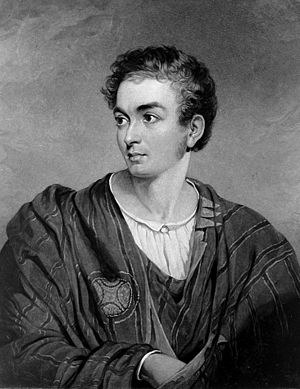Richard Lander facts for kids
Quick facts for kids
Richard Lander
|
|
|---|---|

Richard Lemon Lander in 1835
|
|
| Born |
Richard Lemon Lander
8 February 1804 Truro, Cornwall, England
|
| Died | 6 February 1834 (aged 29) |
| Cause of death | Injuries from a musket ball wound |
| Occupation | Explorer |
Richard Lemon Lander (8 February 1804 – 6 February 1834) was a British explorer of western Africa. He and his brother John were the first Europeans to follow the course of the River Niger, and discover that it led to the Atlantic.
Biography
Lander was the son of a Truro innkeeper, born in the Fighting Cocks Inn (later the Dolphin Inn). Educated at 'Old Pascoe’s’ in Coombs Lane, Truro, until 1817 when, aged 13, he accompanied a merchant to the West Indies, where he suffered an attack of yellow fever in San Domingo. Returning home in 1818, he gained employment as a servant to several wealthy London families with whom he travelled in Europe.
Lander's explorations began as a servant to the Scottish explorer Hugh Clapperton with whom he went in 1823 to the Cape Colony, and then on to an expedition to Western Africa in 1825. Clapperton died on 13 April 1827 near Sokoto, in present-day Nigeria, leaving Lander as the only surviving European member of the expedition. He proceeded southeast to Kano and from there decided to travel south to Funda on the Benue River which led him to becoming the first European to visit the important town of Zangon Katab whose people, the Atyap he described in his notes before returning through the Yoruba region to the coast and thence Britain in July 1828.
Commissioned by the British Government, Lander returned to West Africa in 1830, accompanied by his brother John. They landed at Badagri on 22 March 1830 and followed the lower River Niger from Bussa to the sea. After exploring about 160 kilometres of the River Niger upstream, they returned to explore by canoe the River Benue and Niger Delta. In the delta they were kidnapped by the locals at Aboh, and a large ransom was demanded by the local king Obi Ossai of Aboh kingdom, which was paid. The Lander Brothers were ransomed by Kingboy Amain, the heir to his father King Forday Kulo of Nembe Brass Kingdom, a Kingdom involved deeply in the oil palm trade and slave trade between the hinterland and critical to British interests, in present day Bayelsa State.
Kingboy Amain took them to Nembe and they arrived on Monday, November 15, 1830.
A few days later, on the 17th, Richard was taken to Akassa at the Nun estuary of the Niger River to persuade an English merchant Captain Luke, to repay the ransom along with other gifts paid by Kingboy Amain while John remained in Nembe between the 17th to the 23rd of November. John joined his brother Richard at the Nun estuary of the Niger at Akassa and subsequently sailed back to Britain.
The Lander Brothers admitted that the ransom was never paid back yet they were granted safe passage back to a British ship in their Journal despite the displeasure of Kingboy Amain in the Captain not repaying his money. He was instrumental in their safety and return.
Despite this setback, they were successful in determining the great river's course and termination. They travelled back to Britain from Fernando Po via Rio de Janeiro in 1831.
In 1832, Lander returned to Africa for a third and final time, as leader of an expedition organised by Macgregor Laird and other Liverpudlian merchants, with the intention of founding a trading settlement at the confluence of the Niger and Benue rivers, using two armed paddle steamers, the Quorra and the Alburkah. However, the expedition encountered difficulties, many personnel died from fever, and it failed to reach Bussa. While journeying upstream in a canoe, Lander was attacked by natives and wounded by a musket ball in his thigh. He managed to return to the coast but, the bullet being too deep to remove, gangrene set in, and he died. He was buried in the Clarence cemetery in Fernando Po. He was survived by his wife and daughter. According to a document in the John Holt papers in the Bodleian library (mss air s 1525 Box 11 folder3 p 8) the musket ball is in the Rotunda museum of artillery at Woolwich (Object Class XXX No 172 presented by Col Nichols RM, at whose house Lander died).
Legacy
In Truro, Lander's Monument by English sculptor Neville Northey Burnard stands at the top of Lemon Street, and Richard Lander School is named in his honour, as is housing estate Trelander which in Cornish means home or town of Lander.The building of the column commenced in 1835. In 1832 he became the first winner of the Royal Geographical Society Founder's Medal, "for important services in determining the course and termination of the Niger".
To mark the 200th anniversary of the birth of Richard Lander and celebrate the Lander brothers’ achievements an 'Expedition of Goodwill' was sent in November 2004 to retrace their river journey.
See also
 In Spanish: Richard Lemon Lander para niños
In Spanish: Richard Lemon Lander para niños
- List of explorers
- Explorations (disambiguation)



